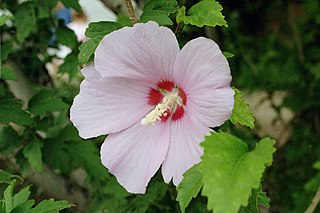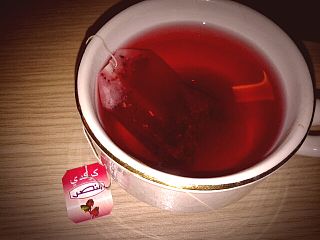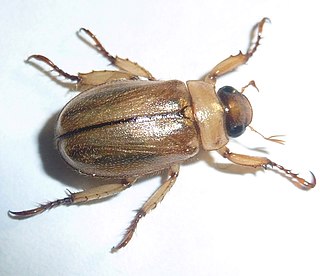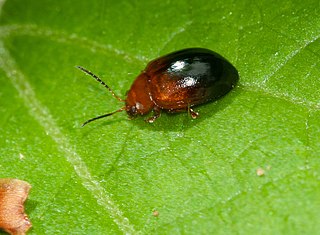
Genus is a taxonomic rank above species and below family as used in the biological classification of living and fossil organisms as well as viruses. In binomial nomenclature, the genus name forms the first part of the binomial species name for each species within the genus.

Hibiscus is a genus of flowering plants in the mallow family, Malvaceae. The genus is quite large, comprising several hundred species that are native to warm temperate, subtropical and tropical regions throughout the world. Member species are renowned for their large, showy flowers and those species are commonly known simply as "hibiscus", or less widely known as rose mallow. Other names include hardy hibiscus, rose of sharon, and tropical hibiscus.

Hibiscus syriacus is a species of flowering plant in the mallow family, Malvaceae. It is native to areas of east Asia, but widely introduced elsewhere, including much of Europe and North America. It was given the epithet syriacus because it had been collected from gardens in Syria. Common names include the rose of Sharon,, Syrian ketmia, shrub althea (or simply althea), and rose mallow. It is the national flower of South Korea and is mentioned in the South Korean national anthem.

Hibiscus rosa-sinensis, known colloquially as Chinese hibiscus, China rose, Hawaiian hibiscus, rose mallow and shoeblack plant, is a species of tropical hibiscus, a flowering plant in the Hibisceae tribe of the family Malvaceae. It is widely cultivated as an ornamental plant in the tropics and subtropics, but its native range is Vanuatu.
Hawaiian hibiscus are seven species of hibiscus native to Hawaii. The yellow hibiscus is Hawaii's state flower. Most commonly grown as ornamental plants in the Hawaiian Islands are the non-native Chinese hibiscus and its numerous hybrids, though the native Hibiscus arnottianus is occasionally planted.

Hibiscus tiliaceus, commonly known as the sea hibiscus or coast cottonwood, is a species of flowering tree in the mallow family, Malvaceae, with a pantropical distribution along coastlines. It has also been introduced to Florida and New Zealand. It has been debated whether this species is native or introduced to Hawaii.

Hibiscus tea is a herbal tea made as an infusion from crimson or deep magenta-colored calyces (sepals) of the roselle flower. It is consumed both hot and cold. It has a tart, cranberry-like flavor.
Reed Publishing (NZ) Ltd was one of the leading publishers in New Zealand. It was founded by Alfred Hamish Reed and his wife Isabel in 1907. Reed's nephew Alexander Wyclif Reed joined the firm in 1925. It was a New Zealand literature specialist and general titles publisher, releasing over 100 titles a year including a number of significant New Zealand authors such as Barry Crump, Janet Frame and Witi Ihimaera.

Adoretus is a genus of Scarabaeidae or scarab beetles. They are native to Africa and Asia, and two species occur in Europe.
Lyndley Alan Craven was a botanist who became the Principal Research Scientist of the Australian National Herbarium.

Hibiscus was a London restaurant which was owned and run by French chef Claude Bosi. It was opened in 2000 in Ludlow, Shropshire, and won its first Michelin star within a year, and a second in the 2004 Guide. In July 2006, Bosi and his wife Claire announced that they were to sell the location in Ludlow and move closer to London. The property was sold to Alan Murchison, and Bosi purchased a new site on Maddox Street in London. The restaurant closed in 2016.
Adoretus abdolrezagharibi is a scarab beetle, and a member of the genus Adoretus.

HMS Hibiscus was a Flower-class corvette, built for the Royal Navy during the Second World War, and was in service in the Battle of the Atlantic. In 1942 she was transferred to the United States Navy as part of the Reverse Lend-Lease arrangement and renamed USS Spry, one of the Temptress-class gunboats. With the end of hostilities she was returned to the Royal Navy and sold into mercantile service.
Gelonaetha hirta, commonly known as Hibiscus Long-horned beetle, or Long horn teak borer, is a species of longhorn beetle. It is distributed in Sri Lanka, India, Myanmar, Thailand, Laos, Hainan Island, Taiwan, Borneo, Philippines, Micronesia, Polynesia and West Indies.
Adoretus celogaster, is a species of shining leaf chafer found in Sri Lanka.
Apogonia blanchardi, is a species of dung beetle found in India and Sri Lanka.

Nisotra bicolorata is a species of flea beetle in the family Chrysomelidae found in Australia. Coleopterologist Ernő Csíki discovered and first described the beetle in 1940. As the scientific name suggests, N. bicolarata is two-colored, with its top half reddish-brown and its bottom half black. The beetle feeds on Hibiscus tiliaceus, also known as native hibiscus.











